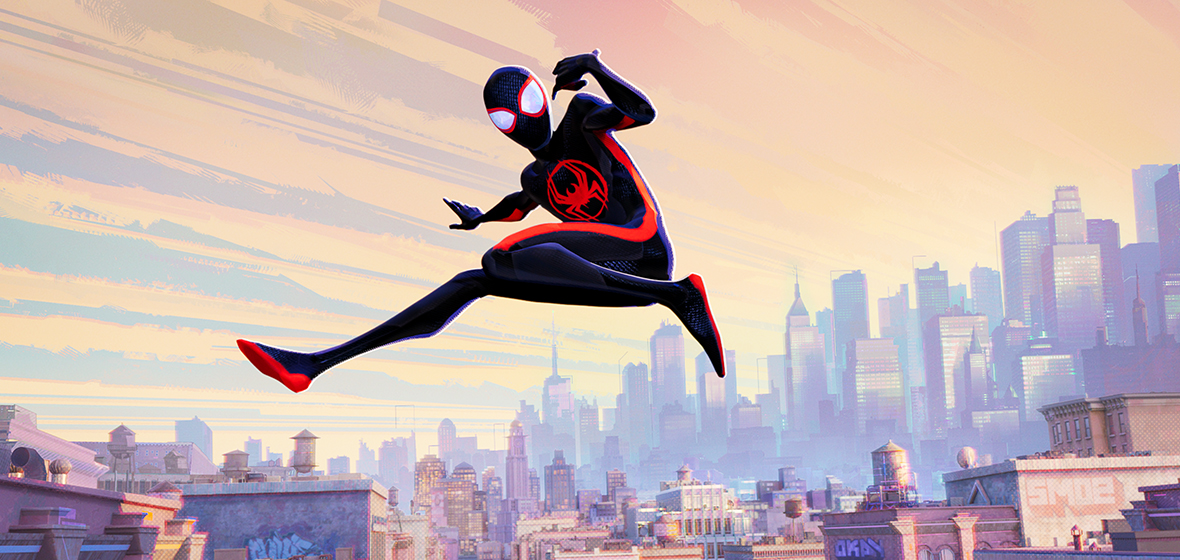Spider-man: Into the Spider-verse (2018) was born from the pettiest business tussle between studios. To recap, Sony owns the cinematic rights to the Spider-man (and everyone connected to him) in perpetuity as long as they release a new film every three years, which is why we had to put up with those awful Andrew Garfield films a decade ago. With public interest waning and not interested in offering a golden goose to its competitors, Sony has allowed Disney to use the character in its cinematic universe as long as the profits are shared, but only if Sony also releases its own stand-alone version of the character.
It became a producer’s game: quickly throwing as many ideas at the wall as possible in the hopes one would stick. And one did – an animated project following the adventures of Miles Morales, a half-black/half-Puerto Rican Spider-Man teen, where the pitch was a dimension-hopping adventure where several versions of the character meet.
That film had no right to be great. It was a cash grab made only to tick a legal requirement. It cost almost a third of the cost of the first Garfield film and about half of that for an average animated project. And because the stakes were low, Sony bigwigs didn’t feel compelled to meddle with the production, letting enfant-terrible co-writers Phil Lord and Rodney Rothman steer the ship.
Sometimes the blackest hole of cynical capitalism can create beauty. It was purely accidental, but Into the Spider-verse was a pure triumph. A visual feast, it had so much coolness it made all other superhero films look like boring squares. The story was tight and unpredictable, and it became a case study in screenwriting courses. It would’ve set the standard, but every studio understood something that good could not be easily replicated.
The good news is that this sequel is not only a worthy follow-up to that genre-defining film, but is also, in many ways, better than the original. It’s The Godfather Part 2 to The Godfather. The Empire Strikes Back to Star Wars. Spider-Man 2 (2004) to Spider-Man (2002).
The story catches up on Miles (Shameik Moore), now comfortable as the only superhero in his universe. An encounter with a dimension-hopping bizarre villain named Spot (Jason Schwartzman) reconnects Miles with Gwen Stacy (Hailee Steinfeld) and introduces him to an elite group of Spider-Men from different dimensions working to keep the fabric of the universe intact. There’s one from the year 2099 (voiced by Oscar Isaacs), a pregnant-motorcycle-riding lady (Issa Rey), a British anti-establishment Spider-Punk (Daniel Kaluuya), an Indian version (Karan Soni) from a modernised iteration of Mumbai, the original Peter B Parker from the Sam Raimi films (but voiced by Jake Johnson), and a whole section where every version of Spider-Men cohabits like they are co-workers at Google or something like that.
The opportunity to throw as many visual gags, and make as many pop culture references, as possible is not lost on the filmmakers, and if you’re a Spider-Man scholar, there’s a lot of “I get that reference” to keep you entertained; for others, everything is just a cacophony of funny visual gags that don’t impair the enjoyment. And here, all the credit goes to the writers (Lord returns, now with his partner Chris Miller and superhero veteran Dave Callahan), who understand that the personal stakes are more important than the big picture. It’s never about saving the world; it’s about dealing with the consequences of our actions and learning from our mistakes. Morales is only fifteen years old; not disappointing his parents is a bigger deal than the fabric of the universe.
Miller and Lord are talented screenwriters. Their gags can be hit-and-miss, but only a few writers can structure a film so tightly while challenging the rules of storytelling. The film’s final act is a sequence of several twists, one after the other, that never jeopardise its structure. I can only strive to have that much confidence in writing.
The quality of the plot was never an issue – Miller and Lord rarely disappoint – but the film stands out against the first one on the visual front. Three filmmakers – Joaquim dos Santos, Kemp Powers and Justin K. Thompson – work together to allow their animators to shine through. The frame here is that each Spider-man is animated like the world they are from, so Miles is animated like the first film, Gwen is a beautiful concoction of impressionistic watercolours, and the spider-punk is like newspapers cut out a la Sex Pistols. There’s a sequence at the start where Gwen fights a villain who comes from Italian Renaissance, animated like detailed Da Vinci drawings, and it’s so gorgeous I let several “oh my God” gasps slip out loud (also that fight is inside the Guggenheim Museum and it features the villain decapitating Jeff Koons’ balloon dog, as if I needed any more to make me love this film).
If there’s a caveat, it’s that the animators probably loved this a bit too much. There is too much information in it, especially in the Spider-Men headquarters, which can make for an exhausting experience. But it doesn’t detract from the enjoyment. It’s just the filmmakers having a field day before getting down to the real business.
Spider-Man: Across the Spider-Verse is the rare blockbuster that shouldn’t be one. A swinging visual feast. A plot expertly crafted in a complex web of twists and turns. A – spidering achievement? OK, I’ll stop; you get the point. Go see it.
Verdict: 5 out of 5
For everyone who has been claiming superhero fatigue. This film is a delightful transgressive art born out of a cynical business decision.




